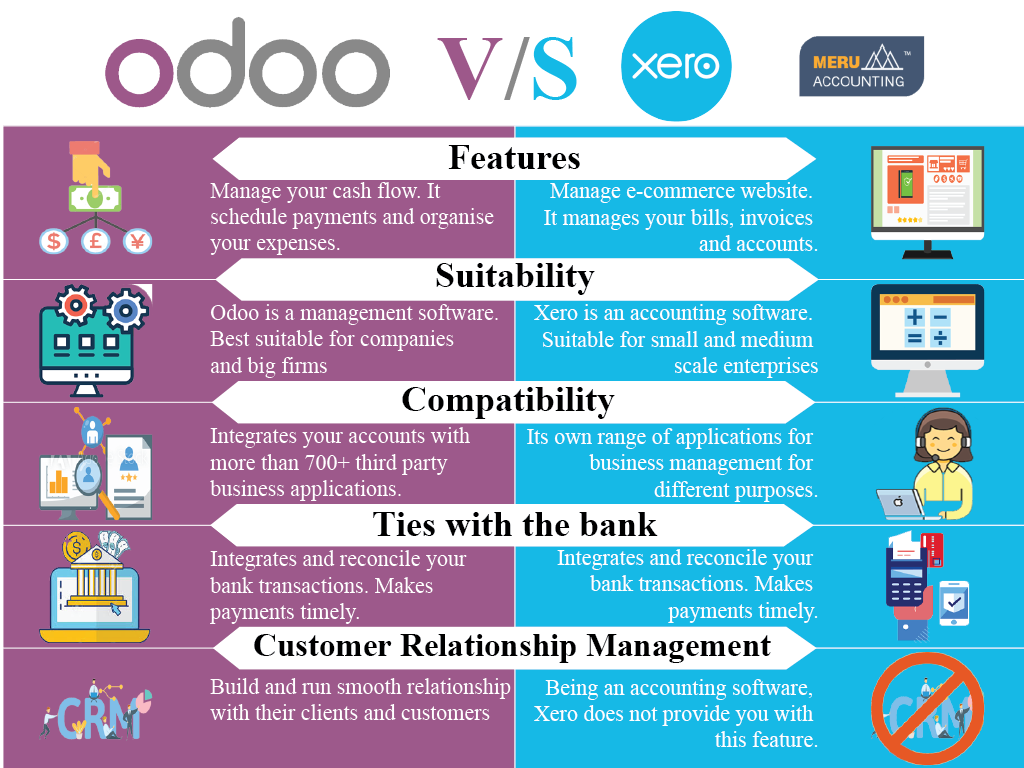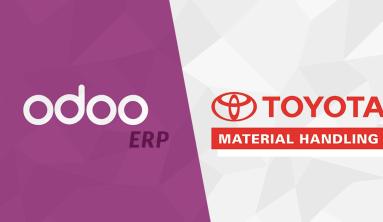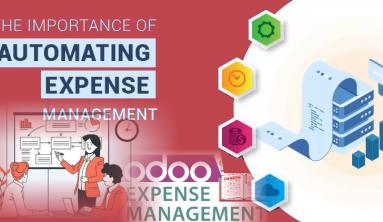Outsource Accounting these days is catching the pace. Companies, nowadays are opting more for it.. it allows companies to handle their business more efficiently by eliminating the burden of manual accounting that involves a lot of paper work.
Outsource Accounting involves an application software that reads and manages all their accounts. The market is full of these kinds of accounting software, each one having their own specific kinda of features. Some are available free, some are by subscription. But choosing which one will be best suitable for your business is the real task.
We narrows that path for you and is here with two best of their kinds of softwares; Odoo and Xero and their brief comparison.
1. A detailed comparison of leading Accounting software for SMEs
Both Xero and Odoo are amazing accounting platforms. Sometimes, the question we advise customers to ask is not about which is better than which, but about which is more suitable for their businesses.
As we are in the business of creating the best software extensions for our customers, we would like to provide you with more insights on whether Xero or Odoo works best for your online store. If you are still unclear on what to choose, please read through this article. Do feel free to contact us any time through our e-mail below if you still have questions.
1.1. About Xero
Xero is an online based accounting software. It manages your cashflow, schedule payments, invoices, account payable etc. in real time. It also tracks your sales and purchase.
1.2. About Odoo
Odoo is a management software that provides you with a complete package of applications that is needed in a business. Like from managing accounts and invoices to managing customers relations, making websites, managing e-mails etc.

- Features they provide: Xero allows you manage your cash flow. It schedule payments and organise your expenses. It generates online invoices and keeps a track of it.
Odoo helps your create and manage your e-commerce website. It manages your bills, invoices and accounts. Keeps an eye on manufacturing and inventory department. - Suitability: Odoo is a management software that has wide range of applications, whereas Xero is an accounting software. The size of the firm is what matters most. More the complexity business involves, more it need a high-end management. So, Odoo is best suitable for companies and big firms and Xero is suitable for small and medium scale enterprises.
- Compatibility with other applications: Xero integrates your accounts with more than 700+ third party business applications easily. On the other hand, Odoo has its own range of applications for business management for different purposes.
- Ties with the bank: Xero and Odoo, both the software integrate and reconcile your bank transactions to. It helps them to make payments timely and avoid double payments.
- Customer Relationship Management: Odoo has this feature of CRM i.e. Customer Relationship Management. it helps the company to build and run a smooth relationship with their clients and customers. It integrates the services provided by the company. Being an accounting software only, Xero does not provide you with this feature.
3. Xero vs Odoo: A Brief Comparision
In general, if we look at numbers, we can clearly see the number of subscribers of Odoo nearly triples that one of Xero (Over 2 million vs just 700,000). Not only that, Odoo’s total number of apps makes Xero’s number of add-ons modestly disappointing (7,300 apps vs 400+ add-ons). But Xero has an edge in terms of partners. Xero’s 16,000 partners are still a testament to its popularity. In contrast, Odoo, being an open source software and utilized in over 120 countries, has just merely 730 partners.
As mentioned previously, Odoo is an open source software. In contrast, the developers of Xero decided that it should only be available through SaaS (software as a service) offer. In scope, we can also observe that Odoo offers more than just accounting like Xero. Odoo’s large user base is also the result of its array of applications, in addition to its open source nature. You can view Odoo as something like an Apple iMac: All-in-one, covers everything from website/e-Commerce, billing, accounting, manufacturing, warehouse to and project management, and inventory. Meanwhile, Xero resembles an IBM supercomputer intended to run a specific purpose, in this case, strictly accounting.
When you visit our online store and look for an accounting solution for your marketplace, these details may be the first for you to bear in mind before purchasing our Xero or Odoo extensions.
3. Xero vs Odoo: In Specific Details
Now that we have an overall understanding of what these two platforms are, let’s take a closer look at features: how they work and what they cover. Remember that do not take any single comparison factor as a means to make your choice. Every factor can be interdependent, so it’s best if you understand thoroughly well what your business needs the most before deciding.
3.1. Xero vs Odoo: Pricing
If it’s just about accounting, Odoo can be a better starting choice for startups because its accounting app is free, albeit with no support. Xero on the other hand offers users with a Standard $30/month package that includes everything: free trial, free updates, maintenance and full support. This cost can vary however, as you may find yourself in need of another currency, in which case the price might go up. In addition, Xero only offers 6-month contracts, while Odoo does not provide any information about contract duration. Xero also provides users with the option of a free 30-day trial, and offers a starter pack at just $9/month.
Nevertheless, Xero’s monthly $30 price can actually be more viable in the long run, since follow-up support is always necessary. Odoo’s support options are pretty much limited, as you need to purchase other apps alongside the accounting one to receive further support. Furthermore, each app in Odoo has its own individual pricing. Bear in mind, though, that Odoo also charges $25 per user (Enterprise package). While this seems appealing to some, they still need to pay for other apps to get general support for all. So in terms of pricing, it really boils down to whether you are aiming for short-term or long-term cost, just accounting alone or all-in-one. For short-term and all-in-one management, Odoo is better. For long-term accounting, Xero is better (Remember, we are only talking about price here).
3.2. Xero vs Odoo: Features
The Xero vs Odoo argument can have some sense of consensus here, at last. Before you can decide which software to integrate into your marketplace, dig into what features do both these platforms share, what features that are missing from one but not the other, etc. Since both platforms have a lot of features in common, in this part we will give you information on the ones that Xero has but Odoo doesn’t, and vice versa:
Xero-unique features:
- Contact History.
- Customizable Reporting.
- Document Storage.
- Drag & Drop Interface, E-mail Integration.
- Goal Setting/Tracking.
- Mobile Integration.
- Receiving.
Odoo-unique features:
- Activity Tracking.
- Automatic Notifications.
- Custom Fields.
- Opportunity Management.
- Pipeline Management.
- Pipeline Reports.
- Sales Forecasting.
- Task Scheduling.
These are the features that distinguish Xero from Odoo. For other features, both platforms offer the same and possess the same. Each feature can affect original Standard package pricing of both Xero and Odoo, however (as mentioned earlier). For instance, if Xero users need to utilize the multi-currency feature, the cost can go up to $70 a month. Meanwhile, the original $25/user price of Odoo can also fluctuate depending on how many apps and features users use.
Basically speaking, both Xero and Odoo offer amazing common features to all your accounting needs, but the above unique features are the catch to help you pick either of them (and the price, too!). Do not expect everything to be free but with good quality, however.
3.3. Xero vs Odoo: User Interface (UI) and supported platforms
Xero vs Odoo ties here. Both platforms have a robust, good-looking website with smooth animations, albeit different themes. Xero uses a predominantly light blue color scheme, while Odoo UI seems to be more colorful with the primary scheme being purple. All functionalities are easily accessible on the web, as well as on mobile apps.
Choosing which over which at this point largely depends on each person’s aesthetic taste, in addition to price and features. Example: Xero’s dashboard seems to be more traditionally laid out, while Odoo’s dashboard resembles sticky notes on your desktop screen. Or Odoo’s home screen on mobile devices looks like typical home screens of most operating systems, while Xero’s home screen has a straightforward layout that can be more familiar to some. Pick your favorite.
In terms of supported platforms, Xero supports more than Odoo does. Both are available on the web and on Android-based mobile devices, but Xero is also available on iOS-based devices as well. This makes Xero friendlier towards more hardcore Apple fans, yet, able to satisfy Android fans at the same time. So, Xero fairly wins in this aspect. We are still trying to grasp Odoo’s decision to not support iOS devices, but it seems they finally realized the importance of this platform and released an app on iTunes at last near the end of 2016.
Both Xero and Odoo is still not supporting Windows Phones, though. Maybe someday, who knows?
3.4. Xero vs Odoo: Other factors to consider
One interesting fact is that Xero integrates well with other applications such as PayPal, MailChimp, Zapier, Workato, and so on. The number of applications and platforms that can be integrated with Xero (including Magento and Magento 2) reaches 463. In stark contrast, there are only 5 Odoo’s integrations into other applications/platforms so far, Magento 2 included. We will get to the bottom of this soon, but obviously Xero wins again in this one.
Oddly enough, despite offering free accounting app for companies, Odoo’s user base are primarily large enterprises, each with 201-1000 employees. Xero’s most popular users are entry-level startups with dozens of employees, or SMEs. There is an explanation for this, however. Odoo’s nature as an open source, all-in-one management software makes it more convenient for larger firms to handle multitasking. Xero on the other hand seems to be the essential cost-effective accounting tool for startups, but cannot fulfill other purposes. In the perspective of a large company, having Odoo can be more beneficial because of its versatility. Why so? If they pick Xero for accounting purposes then they will need to purchase other apps to integrate into their online stores. Hence, Odoo wins here.
4. Conclusion
Company opting for accounting software must consider some of these factors like size of the firm, nature of the company, before choosing any software for their business.
Accounting software is available either installed locally or through a cloud service provider. While both types of software have their own unique advantages, online offers are becoming increasingly popular choices amongst small and medium size businesses (SMBs) given the simplicity and low cost of implementation.
Xero is a great application for one function: accounting. Xero may be a good choice for SMEs and startups with a simple business model where there are few products and where inventory does not need to be tracked.
However, the choice of accounting software is a key aspect of every business strategy. If you manage inventory in your business, and if you want the flexibility to grow your product list and expand your supply chain, while managing stock levels accurately, then Odoo would be the better long-term choice. Start with the right tools to manage inventory, and reap the benefits of having the accurate information to make confident decisions.
Via TIGO Solutions






